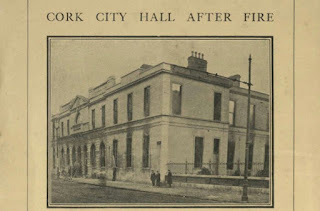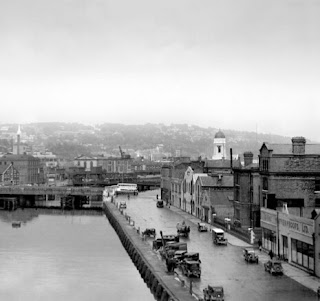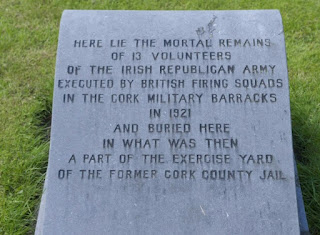During the War of Independence Cork fought the hardest and suffered the hardest. The night of December 11th 1920 demonstrates that.
Dillons Cross
At 8pm the IRA ambushed crown forces at Dillons Cross on the north side of the city. Following this, the British forces retaliated by destroying much of the city centre.
plaque marking spot of Dillons Cross ambush
new plaque unveiled for centenary in 2020
Crown forces arrived back to the scene of the ambush at approximately 9:30pm and proceeded to burn houses in the area. From there they ventured down Summerhill and into the city for a night of looting and arson.
On Summerhill the crown forces stopped a tram and beat everyone off it. From there they went on to King Street (MacCurtain Street) and started shooting at the crowds while breaking doors and windows and helping themselves to the contents of pubs along the street.
The remains of a tram on Patrick Street.
The marauding crown forces headed across Patrick's Bridge shortly before 11pm and there on the city's main thoroughfare they set a tram alight and premises along the street.
They set the Munster Arcade on fire which then spread to Egan's Jewelers and Cudmores along with many other businesses. They set Cash's on fire which spread to the Lee Cinema and premises down Winthrop Street.
The remains of the Munster Arcade. Today the site of Penney's.
With Patrick Street ablaze, the arsonists went towards the South Mall and over Parnell Bridge towards the City Hall at 3am. They burned it to the ground along with the Carnegie Library next to it.
Carnegie Library before it was destroyed .
Inside the City Hall following its destruction.
The remains of Carnegie Library.
By dawn they were looting and destroying premises on Tuckey Street, Grand Parade and Washington Street. One elderly lady living on Tuckey Street got a heart attack and died when the crown forces broke down her door and smashed up her dwelling.
The so called forces of law and order decimated five acres of Cork City, much of it on Patrick Street and left up to 2,000 people homeless or jobless.
Crowds gather on Patrick Street the morning after.
A view of Cash's and the Lee Cinema on Winthrop Street.
Cork city, notably Patrick Street, rose from the ashes some seven years after the crown forces torched it when compensation saw the rebuilding of Cash's and other premises in the rebel city.
Part of the Burning of Cork exhibition at St Peter's North Main Street.
Patrick Street before its destruction 100 years ago.





























































